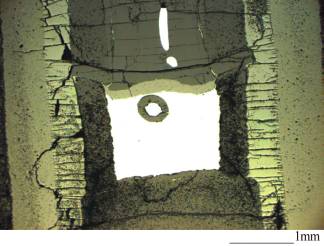

High pressure compressibility of molten Fe-10 wt.%S is being studied in order to understand the composition and dynamics in cores of terrestrial planets and Galilean satellites that exhibit magnetic fields. The composition of the outer core of the Earth is known to be predominantly Fe. The observed density deficit is explained by the presence of a small amount of light element(s). The identity and amount of the light element(s) are still uncertain, but sulphur remains as one of the prime candidates.
The equation of state (EoS) gives fundamental information about the density of this potential core component, which can be compared with the seismologically determined density. This provides a direct means of testing the candidacy of S as the dominant light element.
In the present study we are experimentally determining the compressibility through density measurements of molten Fe-10 wt.%S, using the sink/float method that incorporates the use of novel, tailored density spheres (see Secco et al. section 3.7 for technical details). Composite spheres made of a sapphire shell or mantle and a Pt or WC core are used as probes of the high pressure liquid density. Recovered samples are ground stepwise to expose different sections of samples and spheres (Figs.3.5-1 and 3.5-2). Areal analysis of spheres in combination with known equations of state of Pt, WC and sapphire, yield the HP-HT density of the composite spheres and a comparative density of the liquid sample.
 |
 |
Experiments have been performed between 10 and 20 GPa, and temperatures between 1650°C and 2000°C, using up to 3 composite spheres of different densities in each run. From the experiments so far, 75% of the spheres remained compositionally unaltered.
The lower limit ranges for the density of the Fe-10 wt.%S melt obtained from the densities of the floating composite spheres are 5.3-5.9 g/cm3 for pressures between 10 and 15 GPa at 1650°C and 4.8-6.0 g/cm3 for pressures between 12.5 and 20 GPa at 1850°C.

Tel: +49-(0) 921 55 3700 / 3766, Fax: +49-(0) 921 55 3769, E-mail: bayerisches.geoinstitut(at)uni-bayreuth.de
 Previous page
Previous page